As an Amazon Associate I earn from qualifying purchases.
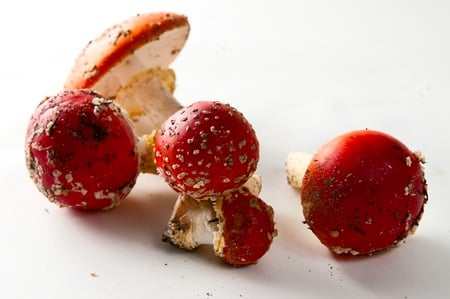
Editor’s Note: I have said this a lot in the comments before, in person and in the body of this post. Let me say it one more time, right up here in the beginning: Unless you are an expert mushroom hunter and you can 100 percent identify this mushroom, DON’T EAT IT. I wrote this post for other experts, not for just anyone to think they’ve found A. muscaria. This is serious stuff, folks. Mistake this mushroom for another amanita and you can die. Seriously. ~Hank
No mushroom presents more of an enigma than the fly agaric, Amanita muscaria. It is the most recognizable mushroom on the planet, and is widely known as the hallucinatory ‘shroom responsible for Alice’s trip into Wonderland and quite possibly our beloved images of a red-suited Santa Claus and his flying reindeer.
I am not into hallucinations. Or stomach cramping, for that matter. So for years I let this beautiful mushroom pass on my mushroom hunts. Until last weekend. We were ostensibly hunting for porcini, Boletus edulis, but as any king bolete hunter knows, the fly agaric is literally a red flag indicating that a porcino might be nestled nearby: They flush around the same time, in around the same place. And where we were on California’s Central Coast there were thousands of muscaria, a red tide in the woods.

As we walked, picking porcini and other wonderful boletes, I began having a nagging conversation with myself: You know you can eat those amanitas, right? Yes, but don’t they need all sorts of crazy processing first? Probably. But you will never get a better chance to experiment than with this flush right here, right now. OK, OK. I grabbed a separate bag and began picking.
I filled a grocery bag in no time. In fact, I could have filled the back of my pickup with muscaria. But I also had a huge haul of porcini, the prize of the day. So I dealt with them first. My dehydrator ran morning and night for days. I made porcini powder, dried quarts of porcini, made porcini risotto, and even gave some fresh ones as Christmas presents. All the while my sack of amanitas lay neglected in the garage.
I came up for air a few days ago and decided to do some research. I have a lot of mushroom books. Most say that Amanita muscaria is toxic and hallucinatory. A few call it deadly poisonous, which seems to be a stretch considering there are fewer than a handful of confirmed deaths by this mushroom and all have extenuating circumstances. (A side note: fly agaric appears to be attractive to dogs and cats and can kill them if they eat it, so keep it away from your pets!)
There is also, apparently, an entire modern subculture dedicated to tripping on this mushroom, and its use in visions dates back thousands of years — especially among those who live in the boreal forests of the north.
This is where Santa comes in. My colleague Greg Marley, whose excellent book Chanterelle Dreams, Amanita Nightmares: The Love, Lore, and Mystique of Mushrooms goes into this at length, says that fly agaric has been a symbol of yuletide happiness in Central Europe, Russia and Scandinavia for centuries, calling it “a red light shining bright in the winter darkness.” And the people of the North, as any mushroom hunter knows, are mad about mushrooms.
There is a common exchange between us Anglo ‘shroomers when we see various, “lesser” species of ‘shroom: Is it edible? Well, the Russians eat it… Amanita muscaria falls into this category.
Historically, the Siberians boiled fly agaric and then drank the pot liquor to get roaring drunk. They then preserved the mushrooms for eating later. As it happens, the Siberians’ livestock also loves this ‘shroom. And I’m not talking about cattle, I’m talking about reindeer.
Yep. Caribou will seek out Amanita muscaria just for the high — or at least it looks that way to us humans. So it’s not too far a stretch to conjure up an image of a jolly, roaringly drunk, fat, bearded dude all dressed up for the North Pole — in a red suit with white trim — chillin’ with flying reindeer.
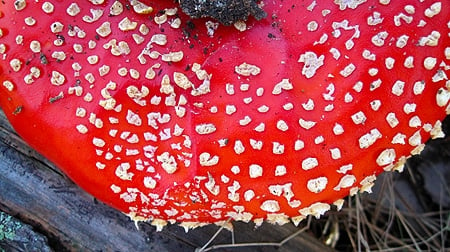
But like I said, I am not into that sort of thing. So I looked deeper. It seems that the primary toxins, er, “active ingredients,” in Amanita muscaria are ibotenic acid and muscimol. Unlike the amatoxins in the deadly amanitas — the death cap and the destroying angel — ibotenic acid and muscimol are water soluble.
More research turned up William Rubel, who knows his stuff when it comes to mushrooms. Rubel wrote an article about how to detoxify fly agaric that proved enlightening.
What’s more, he and David Arora, who is even more reknowned in the mycological world, teamed up on a longer piece (which is linked to at the bottom of Rubel’s article) about cultural attitudes toward Amanita muscaria that provides all the detail you could need on why this mushroom has such a varied place in our minds: Food. Poison. Hallucinogen.
As food, fly agaric does need special handling. Apparently most people eat only the caps or the very young buttons. They must be boiled in a large volume of water for a period of time, and then you need to toss out that water. After that, most cultures will either fry them like normal mushrooms, or pickle them, or preserve them in oil; I happen to know that a certain set of Italians do this. The Japanese around Nagano eat Amanita muscaria as pickles, as do the Lithuanians, Finns and Russians.
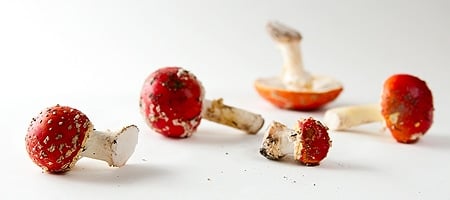
My friend Langdon Cook wrote about eating fly agaric with none other than David Arora, and he pronounced them delicious. Lang also pointed me to a cautionary article written by two mycologists who, apparently, failed to detoxify their muscaria enough. The moral of that article is to use lots of water and boil the hell out of the shrooms.
Back to my grocery bag. By the time I’d screwed up enough courage to mess around with these things, about half had gone by. Bummer. But I still had about 10 good caps to experiment with. What follows is what I did to detoxify the mushrooms. If you choose to play around with Amanita muscaria, do so at your own risk.
- I first removed all the caps and cleaned them with a brush and the side of a knife. Then I cut the caps into 1/4 inch slices.
- I filled my 12-quart stockpot up to the top, leaving about 3 inches of room to spare. I added enough salt to make the water taste salty and 1 cup of cider vinegar. Several sources say that adding salt and vinegar helps extract the toxins.
- I brought this to a boil and added the mushroom caps, then let it roll for 15 minutes.
- I then drained the mushrooms and filled the stockpot half full with fresh water and brought that to a boil. In went the mushrooms for another 5 minutes. Why? If they had gotten too vinegary or salty, this would help. Also, better safe than sorry.
The key to boiling seems to be time and water volume. You need enough water to leach out all the toxins of the mushroom, so it follows that the more muscaria you boil, the more water you’ll need. As for time, it seems 15 minutes is a pretty good interval, according to my sources.
When the slices were done with this treatment, almost all the color was gone from the previously pretty red caps. Oh well. They were still a vague ivory-yellow, but the mushrooms themselves were pale and slippery. Not appetizing. Lang and Arora ate them fried in butter, so I did the same.
I experimented with about 1 cap’s worth of slices. It is always wise to start small with any new mushroom, and especially one that has potentially toxic effects. I put the slices into a non-stick pan and let them dry saute for a few minutes. They did not exude too much water, oddly, so I added some butter and a little salt. I was happy to see the slices fry up crispy. Now we’re talking!
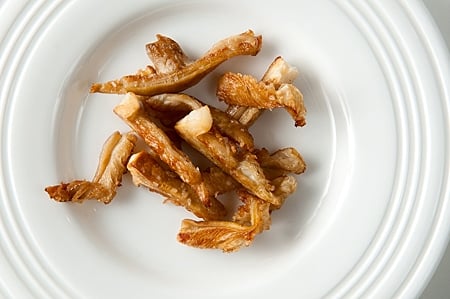
I put them on a little plate, and tentatively took a bite. I’d be lying if I told you I was not at least a little nervous. I tasted butter and salt at first, always nice, but then I got a little crisp, then the squinchy crunchiness of the mushroom, then that nutty flavor everyone who’s eaten muscaria talks about. Reflexively, I reached for another slice, then another and another.
I had to force myself to stop at 1 cap’s worth. They were that good. Now it was time to wait.
The mycologists who’d boiled their muscaria in too little water for too short a time started tripping at 20 minutes. So I sat down to watch Boise State beat the crap out of Arizona State and waited. I was wondering if Boise’s crazy blue uniforms would spark some weird hallucination. But no. I looked at my watch: 45 minutes and nothing. The game got boring. Holly and I then watched a show about a bunch of Vikings getting beheaded in England 1000 years ago, which, in retrospect, was probably not ideal if I were about to go on a mushroom trip. But no. I looked at my watch again: Two hours had passed and nothing.
If a trip were coming, it would have hit by then. What’s more, I had neither stomach cramps nor any other ill effects whatsoever. Success!
Now you may be asking yourself why I would bother messing around with Amanita muscaria when I had just hauled in pounds of boletes? First off, fly agaric is one of the easiest mushrooms in the world to identify. Even though it has some color variation, like the yellow-orange one below, if you stick to the red and orange color phases Amanita muscaria is unmistakable.
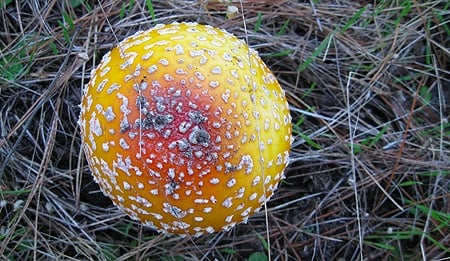
Now white and light-yellow phase muscaria do exist, but I do not recommend messing with those. White amanitas are almost always deadly — the destroying angel chief among them — and mistaking a destroying angel for a white muscaria will be the last mistake you ever make.
And with the yellow ones, you can mistake muscaria for the more-toxic Panther Amanita, Amanita pantherina, which does not have a history of culinary use.
A second reason to consider eating fly agaric is because it is a large mushroom that, as I saw on the Central Coast, can flush in huge numbers. I could easily have collected four grocery bags of them on my last trip, which would have made for lots of good eating down the line.
And good eating is the real reason I will choose to eat Amanita muscaria once or twice a season. It was a delicious mushroom fried in butter, and I suspect it will make an even better preserved mushroom, if the Italians or Russians’ experience is any indication. At the very least, it will be a conversation starter, eh?





Brilliant article.
It reminds me of the old saying here in England- ”
“ALL Mushrooms are edible. But some of them only ONCE !”
This mushroom is indeed ‘psychedelic’, at larger doses (i.e. 1, 2, 3 + full dried caps), but at slightly more moderate doses, after proper drying (and smoking/singeing to kill any bugs therein before the drying process), say, a piece the size of a US quarter, or even two quarters, steeped in cold water for 30 minutes, gives something more of a tonic effect, such as experienced by a larger dose of ginseng, but with its own very distinct character. You can, of course, boil off the chemical muscimol, and they are delicious tasting as a simple mushroom, but why miss out on the energy aspect of this beautiful herb? It’s a wonderful fungus for musical appreciation, as well as when lots of energy is needed to do some labor, but watch out! cause you might not know your own strength. Indeed, this mushroom can make us exaggerate movements in ways that we weren’t expecting, as well as give us physical hallucination, such as where you think you are holding on to something, but there is nothing there (such as, with holding a cigarette or joint). Again, this is mostly an issue at higher doses, and starting with a small, even homeopathic dose will give most people an idea of the character of the red Santa fungus. 🙂
Hallo from north Greece! we do eat them after boiling for a while…my favorite recipe is frying them in olive oil with onions and adding at the end eggs and turmeric a great tasting omelette!
i have heard of a story though that happened during 2nd world war at the forest next to my home, a group of partisans ate lots off them, cause of starving and they ended up killing each other… its recorded officially by doctors. Maybe they combined it with wine or with pantherine …
I’m so excited to try this, I live near the mountains i New Mexico, where the “deadly” Amanita Muscaria are in abundance. Can’t wait for next summer when I be picking mushrooms everyone else passes by. Thanks!
Where can u find the mushrooms? Are there any in the northwest? Can I buy them online?
Further Reflections on Amanita muscaria as an Edible Species
https://www.mushroomthejournal.com/bestof/muscaria_revisited.pdf
Fried a small cap in butter last night. Tasty. Boiled 4 large mushrooms, then cooked in butter as well. Yummy.
Thanks for the article.
Just ate them as I said. Simply delicious! Tasty. I ate them butter fried as the blog suggested. Then I deep fried them. They tasted awesome.. Then I used an A. Caesarea recipe to make some pasta. As a result: an awesome experience. I cooked the A. Muscaria at least four times in the water (better safe than sorry). No regrets. A must try mushroom every year! e
I cut my Amanitas into slices and dried them. I dried them in the sun and after a day or so there were some maggots on them which i brushed off. After they were dry, I ate a small piece and waited. The mushroom spoke to me and told me it was ok to eat another piece. After that I simply waited for the mushroom to tell me how much I could eat and I enjoyed the high. I did learn that some specific amanitas have different amounts of magic – and too much could make you feel queasy.
Gotta try this this week. Its amanita’s season right now in Colombia!!! I’ll boil them 3 or 4 times. As you said: better be safe than sorry.
Anthony: Yes. You REALLY need to know your stuff with these mushrooms.
Are there deadly looka likes of the yellow/orange Amanita?
Also skip beer, soda or other carbonated stuff if there are any of the “fun” chemicals left (muscimol); disappears when heated over ~100 celsius.. It might then be converted to ibotenic acid (not good) disappears over ~60 celsius or something like that.
i took 2 large dried caps, grinded them up in a blender then mix with apple sauce, took about an hour to kick in, it made me feel delirious, like going to the fridge to get a drink of water was really hard, cause first of all you have no sence of time, i had no idea if i just got done drinking the water or if i havnt got up to get it, it felt like i was in every room of the house at the same time, it wasnt fun, but at the same time im glad i tried it.you can order dry caps off boucing bear.
great post.
I own a wild mushroom business.
http://www.untamedfeast.com and have made a few videos on the same
subject. I have harvested with David Aurora, and he has told me the same about boiling …throwing out the water and eating.
I have truckload potential of them on a good porcini year.
perhaps this will be the fall season to give it a try.
I do suspect that within a few generations the fly agaric will
become a well known and wellharvested wild mushroom.
certianly safer than many foods we put into our bodies I would say.
thanks again.
Eric Whitehead.
This is a very tasty mushroom. I have eaten them dried with only minor hallucinatory effects. Just know what you are getting in to. I had an odd dream in a semi-sleeping state that I remember to this day. I was on the outside of a long wall of mullioned windows and there was a large party on the other side. Was I being given a glimpse of the “other side?” Later that night I awoke and needed to go to the bathroom. On the way there, I had the oddest sensation of being split into two beings – one lagging behind me as I walked and the conscious “me.” I now understand the meaning of this.
You could probably boil these prior to drying and have some very tasty snacks without the enlightening effects…
Yeah they where always at my grand parents house, in the woods. Then i grew up and ate some, with two other friends.
Me and one guy ended huging the toilet for a while, the other guy did also but fewer and said (with good experience on drugs) that he did feel alucinogenic effects and that we should do it again but not mixing it with condensed milk like we did.
I want to add that in wikipedia it says that when dry they have a much higher potential alucinogenic effect. We took them as fresh as they come. Never tryed it again but going to do so after reading that dry comment on wikipedia.
Accalia: The white spots slough off when you boil the mushroom.
Mmmm, sounds good.
I will proceed to boil mine with caution, but, do you have to pick off the white spikes?
Many years ago in New Hampshire in the fall we picked amanita sand ate them a few times . I think we sautéed them but don’t recall as it is prob about 40 years ago. The effects were like the tail end of an acid trip. Not overly intense and hallucinatory but definitely noticeable effects. We had been living in a farmhouse in a beautiful setting, with a barn and some outbuildings. In front of the fireplace at around 2 am I painted a watercolor of the entire setting, including the 5 of us who lived there, the dog bothering the porcupine out by the apple tree. Until then my drawings had focused on smaller elements, but it was this night that resulted in a completly unified sense of the setting. imthink my girlfriend in the painting was carrying a mushroom and i conveyed the personality of each house members personality . I can easily imagine if people had developed a way to concentrate the effects and lessen the other toxic effects it might have resulted in more intense experiences. I feel lucky
that our experiment with very little actual knowledge did not result in liver damage or worse.